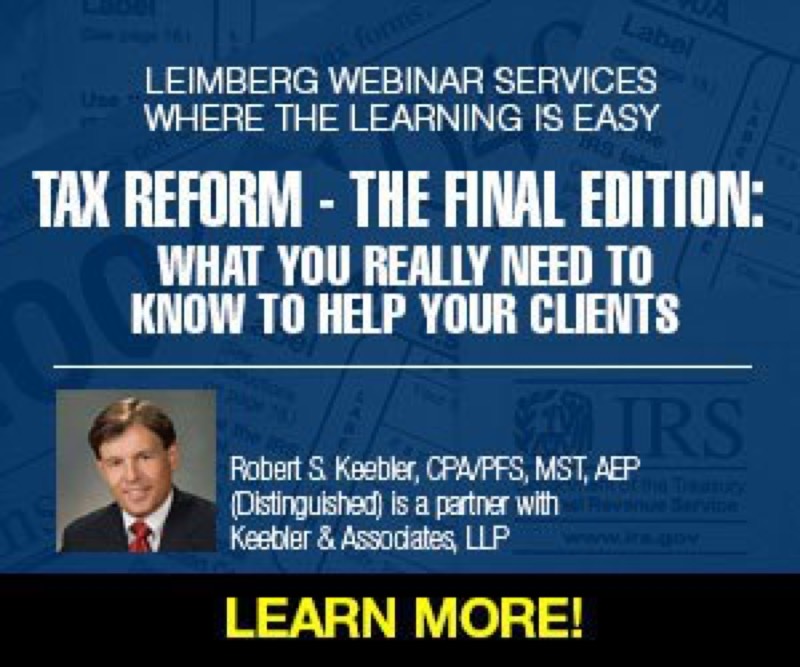
On December 22, 2017, President Trump signed the Tax Cut and Jobs Act into law, overhauling nearly every aspect of the U.S. tax code.
Just ten days later, the new bill will begin to take effect, immediately lowering the top corporate tax rate from 35% to 21%, raising the estate tax exemption from $10 million (per married couple) to $22.4 million, eliminating or limiting most itemized deductions and creating a new 21% deduction for pass through income for some tax payers.
The speed with which the tax bill passed — along with its massive scope and complexity — mean that it will be months, if not years, before all the implications of the new rules have been explored. Its impact on economic growth and, consequently, the stock market will likely be substantial. Already companies including AT&T, Boeing and Wells Fargo have announced increased bonuses and wages due to the bill’s passage, giving an early hint of how tax reform may boost economic growth. Meanwhile, experts are already spotting some significant opportunities for wealth planners and advisors. Here are our top ideas.
1. The pass-through opportunity
One of the most interesting features of the new tax law is a special 20% deduction for pass-through entities – that’s any company that’s not structured as a C corporation, be it an S corp, and LLC or a sole proprietorship. The deduction is available to anyone, in any business, with income up to $157,500 for an individual or $315,000 for a married couple filing jointly.
That mean, for advisors, it may be worth reclassifying income as deriving from your stake in some sort of pass-through business structure — an S corporation, partnership, LLC or solo proprietorship. As an individual employee, you simply owe a slice of your income to the IRS. But when you contribute your labor to the business and take the profit out of the back end, Congress will let you deduct 20% before taxes apply.
There was some debate over whether this deduction would apply to “service businesses” like wealth management, law and medicine. Consensus now says it does — up to gross income of $315,000 for married couples.
After $315,000, thresholds start kicking in, but compared to earned income it's still extremely attractive.
The pass-through deduction may also come into play as financial advisors structure wealth for clients as well, since it is available, subject to the same income limits, for trusts that own pass-through entities like partnerships and LLCs. In a last minute change, however, the bill exempted capital intensive businesses like real estate partnerships from the income limits, so trusts with these kinds of assets can take the 20% deduction regardless of how much money they earn.
2. A window of opportunity for dynasty trusts
By doubling the estate tax exemption, tax reform significantly reduces the number of families and individuals who have to plan to meet estate tax liabilities – but that doesn’t mean it eliminates estate planning.
“One of the key questions is, what are the states going to do?” says Bill Sweet, CFP, an investment advisor at New York-based Ritholtz Wealth Management. The New York State estate tax exemption, for instance, rose to $5.5 million in 2017 to harmonize with the Federal exemption. So far, says Sweet, there’s been no decision on whether New York will raise its own exemption or decouple from the Federal rate. Other states have even lower estate tax exemptions – Rhode Island’s is just $1.5 million. Sweet notes, “So first, there’s still going to be a need for estate planning particularly at the state level. And second, not all of estate planning is tax mitigation.”
“Certainly it’s welcome news that a lot more estates won’t have to pay estate tax. But that’s for a limited duration,” says Doug Mueller, CPA , the president and co-founder of St. Louis-based accounting firm, Mueller Post But he cautions that, since that provision of the bill sunsets in 2026, “We’re telling people to use this opportunity to continue to plan, especially family businesses, now that the IRS had to pull their proposed regulations on 2704 on family discounts.”
Tax reform, in conjunction with the family discount provision, gives business owners an opportunity to transfer large chunks of their private company wealth to the next generation now. Transferring discounted non-voting stock to family members allows owners to move wealth out of their estate now, without losing control of the company.
Other experts say that the new higher exemption creates an opportunity for setting up or expanding dynasty trusts, effectively removing additional money from the estate even if the exemption shrinks in future years. Bob Keebler, CPA/PFS, MST, AEP (Distinguished), CGMA, a partner at Green Bay, Wisconsin-based Keebler & Associates, explains. Let’s say that today, before tax reform, I have a $5 million exemption and II’ve already used it. I’m worth $25 million. I don’t need much money to live on. I’ve used my $5 million. As soon as it goes up by $5 million, if I have $5 million in cash, I’m giving away the next five. And I would put that in a dynasty trust.”
“The new tax act creates a window of opportunity to fund Dynasty Trusts in a state like Nevada. The gift tax exemption and generation-skipping transfer tax exemption are doubled to $10 million plus inflation, effectively giving each individual $11.2 million of exemption to fund a Dynasty Trust in 2018. The inflationary increases continue until the end of 2015 when the exemption drops back to $5 million plus inflation,” says Steve Oshins, a partner at the Nevada-based law firm Oshins and Associates.
3. A new urgency to income tax planning
Under the new law, tax filers can deduct a maximum of just $10,000 in state and local taxes on their Federal return, a provision that will significantly increase taxes for people who live in high tax states like New York and California.
“We’re going to be putting a greater emphasis on income tax planning rather than estate tax planning going forward,” says Oshins. “We’ll be putting a greater emphasis on saving state income taxes using special types of trusts.”
Oshins is speaking, specifically, about non-grantor trusts, which are taxed based on where the trust is domiciled, not where the grantor lives. They allow individuals to move assets — and the income from those assets — from high tax states to low or no tax states, for instance from California where the top marginal income tax rate is 13.3% to neighboring Nevada, which has no state income tax.
“We will be doing a lot of NING, Nevada Incomplete Gift Non-Grantor Trusts, to save state income taxes,” says Oshins. “We were already doing tons of these trusts, but now that state income taxes are no longer deductible against Federal taxes, that is an even greater incentive for people to want to form a NING trust in order to save the state income taxes.”
Oshins says his firm will also be looking for opportunities to decant existing grantor trusts (again taxed according to the grantor’s home state laws) into non-grantor structures.
Mueller adds that the very wealthy may also consider relocating. “Now when you can no longer deduct your income taxes, you might see more and more people thinking about where they live for state tax purposes,” he notes. And where actually moving is too onerous, moving assets may provide a solution. “Steve’s business ought to flourish next year,” he adds.
4. Expanded 529 plans
Another major change affects 529 college savings plans. Up to now, these plans, which exempt investment earnings from Federal tax, and, in many states, carry additional state income tax benefits, could only be used for college and graduate school costs. Starting in 2018, families will be able to use them to fund private elementary and high school expenses.
“Probably the number one question that I would get from clients in their early stages, particularly in New York, is can I use 529 assets for private school, but for primary or secondary school. The answer up to 2018 was no. So this is a brand new ball game,” says Sweet, whose firm is now advising its clients to start funding 529s as early as possible.
The problem is that if parents use 529 assets starting in kindergarten, some will run out before college matriculation. (Contributions are unlimited, but some states have rules on maximum balances and maximum amounts deductible from state income taxes. Gift tax rules also apply, so only the annual exemption of $15,000 in 2018 would be exempt from gift and estate taxes.) And, since only investment income is tax free — that is, contributions are made after tax — the main benefit to investors comes from long-term tax-free compounding. Investors who start pulling money out for kindergarten, after a maximum of five- or six-years, will not get as much of a tax benefit as those who wait the 18- to 20-years for college.
Mueller says, however, that the new rules are a real benefit, despite these limitations. “You might not get much growth, investing for primary school, but for grandmas and grandpas who are doing some estate planning, the new rules provide an opportunity to start giving. I think you can make a case for funding high school with 529s – there you have more than a decade of potential growth.”
5. Bunch charitable contributions for maximum effect
The charitable giving donation survived tax reform intact, one of the few individual deductions to do so. However, because the bill doubles the standard deduction from $6,350 to $12,000 for individuals and from $12,700 to $24,000 for married couples filing jointly, far fewer people will find it makes sense to itemize. A married couple already claiming the maximum $10,000 in state and local tax deductions would have to make gifts of over $14,000 per year to get any tax benefit over the standard deduction.
“For somebody that sits down and writes a check for $1000 once a year, that is, for a lot of folks, there’s not going to be a charitable deduction going forward,” says Sweet. “But for the higher income folks that we work with, we’re trying to find a way to be tax efficient where they can still take advantage of the rules. The deductibility isn’t going away, it’s just that the rules have changed a little bit.
Sweet continues, “We’re advising a number of our clients to make their charitable contributions through donor-advised funds and lump all those contributions into one year. And so for example if you’re going to give $10,000 a year for the next five years, basically do the donation to a donor-advised fund in a $50,000 lump sum up front in one year, take the donation and then through that advised fund then donate the assets to charity in the future.”
Start planning now
The Tax Cut and Jobs Act is an enormous, far-reaching piece of legislation that will affect nearly every sector of the economy — and will likely change your business in many other so far unforeseen ways. But you can start planning now to put its benefits to work for you clients with these five strategies and grow your book of business within the new regulatory framework.




